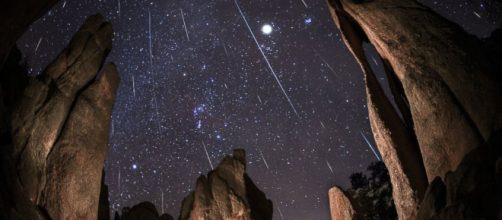Don’t miss the Geminid Meteor Shower tonight and early tomorrow morning (December 13th and 14th). This year, there will be an unusually large number of meteors as the massive 3200 Phaethon grazes the Earth. 3200 Phaethon was the first asteroid / comet to be observed from a spacecraft, on October 11, 1983. It gets its name from the myth of Phaethon, Apollo’s half-mortal son.
The comet takes its name from one of the first teenage driving accidents
According to the myth, when school-mates teased Phaethon and questioned his divine parentage, he went to beg his father for a favor.
Apollo promised to grant whatever boon his son asked, only to eat his words when his son requested to drive the sun’s chariot through the sky for one day. Like all teenage drivers, Phaethon was not particularly skilled or careful and almost crashed the sun into the earth.
The Greeks used this myth to explain why some parts of the earth are hotter than others – the equator caught on fire when Phaethon drove too close. Astronauts chose the story because 3200 Phaethon comes closer to the sun than any other named extra-terrestrial object. As it approaches the sun, scientists have speculated that solar heat causes small pieces of the object to break off. It is this trail of debris that appears in the form of meteors as the comet’s tail collides with our atmosphere.
Why is 3200 Phaethon so mysterious?
One last interesting fact about 3200 Phaethon is that it is a mysterious asteroid / comet “hybrid.” Simply put, whereas asteroids are composed of denser, more metallic elements, comets tend to be lighter. In addition, asteroids orbit the sun in a more nearly circular orbit, whereas comets tend to have a more elongated, elliptical orbit. 3200 Phaethon displays characteristics of both asteroids and comets: while 3200 Phaethon is dense and metallic, its orbit more resembles that of an asteroid.
When are the best times to watch?
If you want to see the show, what is the best time to watch, and where in the sky should you look? The Geminid meteor shower’s radiant point is located near the Gemini or twin stars of Castor and Pollux.
These stars are found low in the East / Northeast at 9PM and ascend more directly overhead around 2PM, meaning late night or early morning are the best times for viewing. While you may see meteors flying through any point in the sky, your best bet is to look to the Gemini because this is the point where all the meteors originate. Since the meteors have roughly parallel paths, as they enter Earth’s atmosphere, they appear to converge in the distance – just like train tracks. And the Gemini mark the point of that convergence. To be sure, the meteors will not be radiating from the Twins themselves – but closest to the twins is where 3200 Phaethon will appear.
Whatever time you choose to watch, make sure to find a wide open area clear of interfering city lights.
In the early evening, you may catch an “Earth-grazer” comet, a spectacular, slow-moving comet that flies relatively close to the Earth. Viewing will be even better after midnight because the moon is a waning crescent and will be less likely to interfere. Finally, you won’t be able to catch 3200 Phaethon with the naked eye, but if you’re curious, you can bring your telescope.
Meteor showers remind us that our planet is one giant “ship” hurtling through space. As the seasons pass, the view from our window changes. Look above tonight and tomorrow morning for a fantastic show.


